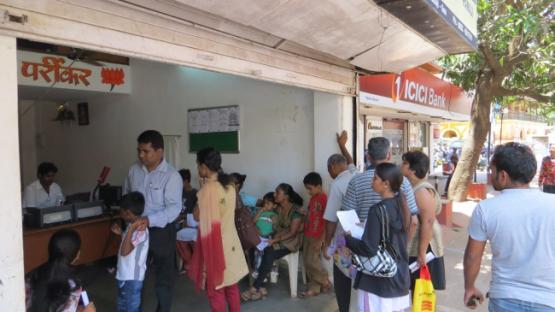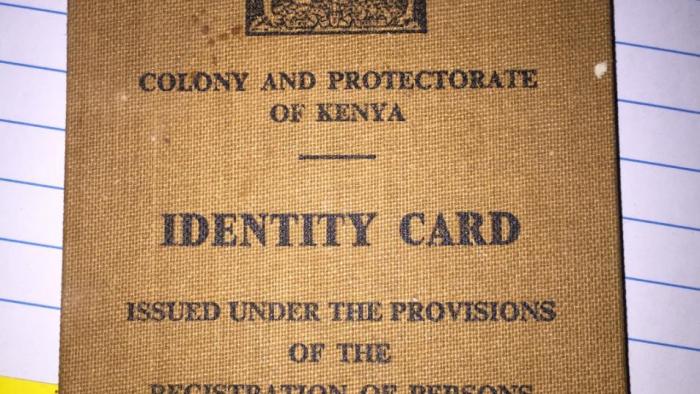
Exclusion by design: how national ID systems make social protection inaccessible to vulnerable populations
Governments around the world are increasingly making registration in national ID systems mandatory for populations to access social benefits, healthcare services, and other forms of state support. By virtue of their design, these systems inevitably exclude certain population groups from obtaining an ID and hence from accessing essential resources to which they are entitled.

This piece was last updated in June 2021.
In many countries, access to social protection (such as welfare programmes or healthcare) is made conditional on producing a form of identification (“ID”). But obtaining a recognised and accurate ID is often a process riddled with discriminatory designs, bureaucracy and technical failures that prevent individuals from accessing the services they are entitled to. Even when people eventually get an ID, it might not accurately reflect who they are, leaving individuals with unique sets of risks and concerns. In a world where an estimated 1.1 billion people have no legal identity, making access to social benefits and healthcare dependent on being registered in a national database, producing an ID card or providing biometrics is excluding a large – often the most vulnerable – portion of the population from vital resources.
Social protection programmes can be broadly understood as government support for individuals to meet basic human needs, protecting citizens from the “economic risks and insecurities of life”. They range from ensuring all children are properly nourished every day through the provision of free school meals, to ensuring equality of all people in health by financing healthcare for all. Provision of such support has come to be considered a fundamental responsibility of modern democratic governments, and a key measure of development.
To be effective and serve their universal aims, such programmes must be accessible to all without discrimination. However, a growing number of programmes require their beneficiaries to produce a form of IDin order to unlock access – a requirement that invariably reduces or denies access to welfare to certain parts of the population. This can be for a variety of reasons, almost all of which come down to the fact that some categories of individuals cannot obtain a piece of ID in the first place: specific marginalised groups are by default or by design excluded from ID access, either because distribution logistics fail or technical features of the system make certain requirements impossible to evidence for some. For example, ID relying on biometrics may inevitably exclude the elderly and manual workers, whose fingerprints fade over time.
This is an overview of the trends we and our partners have observed across the globe, and we thank the Center for Internet and Society, KELIN and Unwanted Witness, for their contributions to this piece. What this analysis demonstrates is that despite all the claims for universality made by proponents of digital identity, the way ID systems are designed and implemented inevitably exclude some people from access to identity credentials, and those who cannot use their identity credentials are denied access to goods and services. The growing trend of governments making access to social protection conditional upon the provision of ID is thereby systematically ostracising certain types of individuals or groups and compounding existing discriminations.
1. Discrimination against specific groups: ID vetting for minorities in Kenya
A straightforward issue with making access to social protection dependent on ID is that ID is often purposefully made difficult or impossible to access for certain marginalised groups. Almost 10 years ago, discrimination in the issuance of national ID cards in Kenya was already investigated and reported by the Open Society Justice Initiative. It found evidence of overt discrimination against ethnic and religious minorities, who were arbitrarily subject to “vetting” procedures and imposed onerous additional requirements to be able to obtain an ID card. A member of the “Vetting Committee” in Mumias Province stated in an interview that “[w]hen [they] vet Muslims and non-Muslims, non-Muslims get their documents like identity cards processed very fast but the Muslim applications have lots of questions and requirements and they would ask for your mother’s birth certificate…and they would even ask for your great grandparents’ identification.”
In 2010, one individual was refused an ID card and told that a “secret government circular” required “Asians and Arabs” to produce parents’ and grandparents’ birth certificates as proof of citizenship. He challenged this policy in court, and in 2011 the circular was suspended for being unconstitutional – but vetting practices still live on today, without those subject to vetting being able to understand why they are singled out, or what criteria will be used for vetting them. Kenyans from minority groups – such as Nubians and Somalis – continue to encounter significant barriers to obtaining ID: in 2015, the African Commission on Human and People’s Rights considered that “Kenya had failed to recognise the legal status of Nubians”.
In 2018, Namati – an organisation working towards legal empowerment and justice, including citizenship justice in Kenya – found that their Nubian clients spend an average of 58 days working on their applicationsbefore they are able to submit them to the registrar, while other Kenyans were able to submit them on day one. Once an application is submitted, in 2018 the average waiting time from the application to issuance of an ID card increased from 95 days to 145 days, excluding vetting time (which occurs before one is even able to submit a formal application) – a time frame that contravenes Kenyan law enacted in 2014, which requires that individuals receive their ID within 30 days of applying. Namati observed that these delays kept worsening in the period 2013 to 2017, evidence that neither the High Court’s ruling on the discriminatory government circular, nor the 2014 law, deterred wider vetting practices.
Some individuals are denied access to an ID card altogether on account of biometric registration. The effect of biometric registration – registration of biometric details in a database – is to entrench identities, and often exclusion. We have seen that play out for ethnic Somali Kenyans, whose inclusion in biometric refugee databases decades ago has now rendered them virtually stateless, leaving them in a legal limbo with no recourse to claim their legitimate identity. This highlights one of the pitfalls of reliance on biometrics for distribution of humanitarian aid.
Delays in obtaining an ID document, or outright refusals to be granted one, result in economic exclusion, social isolation and missed opportunities: ID cards are required for registering at university, getting a job, activating a SIM card and accessing any government building – among many other essential activities. In addition, they are required to receive welfare payments under the National Safety Net Program, a bundle of social cash transfer programmes for the most vulnerable populations.
Following a 2013 law mandating all government payments to be digitised, cash transfers under these programmes are made electronically, relying on a national ID card and/or a biometric fingerprint to identify beneficiaries. Naturally, this has resulted in the exclusion of vulnerable populations – an issue that is now recognised by industry bodies. A report by mobile network association GSMA on digital payments to biometric smart cards notes that “some, often particularly marginalised, beneficiaries do not have national IDs and therefore cannot register for the programme”. In addition, beneficiaries face data mismatches which take at least several months to rectify, and involve stress in fear of disqualification. One of these social cash transfer programmes, which provides unconditional cash transfers (“UCTs”) to “ultra-poor households” with orphans and vulnerable children (“OV/C”), struggles to reach its most at-risk target population: because ID cards are only issued at the age of 18, child-headed households are unable to access those vital benefits – except when ad hoc individual adjustments are made to the distribution system.
2. Logistical failure: delays and errors in Uganda’s National Identity Card system (“Ndaga Muntu”)
Discriminatory designs aren’t the only culprit for the systemic exclusion caused by ID systems. In some cases, the ID production and distribution process itself doesn’t deliver. In 2015, Uganda introduced mandatory biometric ID registration, making access to fundamental resources dependent on obtaining an ID: obtaining a student loan, opening a bank account, acquiring a passport, entering employment, and activating a SIM card all require a national ID. The government even planned in 2018 to prevent pharmacies from dispensing drugs to patients without national IDs.
By 2019, over 2.4 million Ugandans had still not received their ID cards (a number that doesn’t include the Ugandans newly turned 16 or those who lost their ID cards, i.e. understandably waiting for an ID card).Despite a 2015 law stipulating that Ugandans must receive their national IDs within 3 months of submitting their registration forms, in early 2020, only 5% of respondents to a survey by Unwanted Witness had obtained their ID within the statutory timeframe, and 88% were still waiting for their ID over 6 months after having submitted their registration forms. The processing time of national ID requests is therefore not legally compliant in an overwhelming proportion of cases – without any corresponding leniency to allow access to welfare support and healthcare to those whose registration is still pending.
Delays are also compounded by errors whose rectification comes at a cost, borne by individuals who may or may not be at fault, and additional delays. Such errors can be decisive in granting or refusing access to welfare support, such as the Social Assistance Grants for Empowerment, for which only Ugandans over 60 years old are eligible (eligibility was only very recently brought down from 80 years old). One woman, born in 1939 and 81 years old, had her national ID mistakenly identify her as born in 1979, and was therefore ineligible to receive support. Fixing these mistakes comes at a cost of 50,000 Ugandan shillings (nearly 14 USD) a significant amount for people living in chronic poverty.
A report published in June 2021 documented how the current requirements to provide a national digital ID to access social rights led "to mass exclusion, shutting out as many as one third of Uganda’s adult population" in particular women and elderly people from accessing healthcare and social benefits.
The enjoyment of fundamental rights and freedoms should not be made dependent on a process that simply isn’t working properly. The case of Uganda shows that complete reliance on centralised, digital biometric ID systems will necessarily exclude people for at least some time, and sometimes forever, from vital social protection.
3. Technical exclusion: ubiquitous linking of India’s Aadhaar card excludes those physically unable to provide biometrics
Another fundamental problem with biometric IDs is technical. Biometric identifiers are not always accessible for older people, those with disabilities, or those who do intensive manual work. These individuals can face serious complications when having their biometrics collected or when matching them later on.
This issue is recurrent across countries and has been a significant one in the roll-out of the Aadhaar card in India, a biometric ID card required for voting, claiming social security, or activating a phone. For people who struggle to provide their biometrics, including India’s 104 million elderly people and 27 million disabled people, getting an Aadhaar card can be difficult or impossible. Those with involuntary movements or reduced coordination can struggle to give an iris scan or a fingerprint, and a vast proportion of the elderly do not have readable fingerprints anymore. Biometric measurement can also be so intrusive as to cause severe agitation in some people, and in one reported case, seizure. Some adjustments are sometimes made, for example taking a picture of someone’s hands instead of their fingerprints, but because most matching at banks or hospitals is done through fingerprints, an Aadhaar card obtained this way can simply become useless.
Despite a 2015 Supreme Court order that an Aadhaar card must not be a condition for obtaining any benefits, central and state governments made Aadhaar a requirement to access multiple health and social security schemes, such as calling an ambulance, receiving hepatitis C treatment, or donating organs. In 2017, a woman died from an abortion carried out by an unqualified physician, having been denied abortion from a government hospital for failing to produce an Aadhaar card.
Since the launch of Aadhaar in 2011, it has been linked to the provision of an ever-increasing number of goods and services, both from public bodies and private entities. Some banks started refusing to open new accounts for people without an Aadhaar, and insurance firms denying claims if no Aadhaar number was linked. Even sending a parcel abroad could require an Aadhaar number. After widespread campaigning against the dangerous creep of Aadhaar cards in Indian society, in 2018 the Supreme Court forbid private entities from requiring an Aadhaar card as a condition of providing services – but, retracting from its earlier position, and in an attempt to seek ‘proportionality’, decided that the government could mandate the use of Aadhaar cards to distribute government subsidies and benefits. It thereby (surely unwillingly but effectively) affirmed the exclusion of certain groups and individuals from welfare schemes.
4. Creating barriers to accessing essential care: ID as a pre-requisite to accessing Covid vaccination
In late 2020, countries around the world started to deploy nation-wide vaccination programmes for Covid-19.This is one of the largest global healthcare distribution programmes in human history.
Whilst vaccination eligibility criteria are essential to ensure vaccination programmes are fair and cater to those most vulnerable, we saw some governments announcing pre-requisites to accessing vaccination programmes, including having to provide a national ID card/number. But as we warned, tying the vaccine to “immunity passports” or other identity schemes would reinforce and further entrench existing inequalities and exclusions such as those outlined in this piece which would create a state of permanent pandemic for these groups.
Some of the governments we saw doing this have included India, Uganda as well as Indonesia and some states in the USA, to name a few. In India, “[e]ach person in the [Covid-19] immunisation list [will] be linked with their Aadhaar cards to avoid duplication and to track beneficiaries”. In Uganda, the Ministry of Health first announced that providing a national ID card was a pre-requisite but following a legal challenge brought by our partners Unwanted Witness and their local partners the Initiative for Social & Economic Rights, the Ministry changed the policy to allow other forms of ID to be accepted. Whilst this minimises the risk of exclusion, it does not remove it completely. In the USA, requirements were made by some States to provide documents in the form of state-issued ID or proof of residency raising concerns for undocumented migrants and those who never registered for such documents, for example.
The imposition of such requirements is occurring despite extensive evidence of how problematic and discriminatory identity systems are, and documented concerns around ID being a pre-condition for accessing healthcare. We are not alone on this point; this is why the UN Special Rapporteur on Extreme Poverty and Human Rights questioned previously existing mandatory ID requirements for accessing health care services.
Public health programmes should be focused on inclusion, not threatening exclusion. Governments must find alternatives to delivering Covid-19 vaccination schemes which do not perpetuate and reinforce exclusionary and discriminatory practices.
This is an issue we will keep monitoring as it unfolds, and as more countries roll out their vaccination programmes.
Get all our Covid-19 updates straight to your inbox.
Conclusion
For reasons of efficiency, convenience, security or fraud avoidance, many states around the world are resorting to national ID systems for the distribution of social welfare payments and benefits to those entitled. However, national ID systems are often riddled with systemic discrimination, logistical failures or technical loopholes, inevitably leaving some unable to obtain any form of ID. The examples cited in this paper are just a drop in the ocean of uphill struggles faced by millions around the world. Governments must recognise and address failures to cater for those who do not squarely fit within technological systems of identification and registration, ensuring that those individuals are not disproportionately prejudiced by pre-requisites to social protection. Access to social protection is for many the only way to feed ourselves and our family, to have a roof over our head and live with dignity, and to access care when we are sick.
Thus, as they progressively realise economic, social and cultural rights, governments must ensure smooth and easy access and delivery of social protection, and avoid any requirement that hampers access to associated services.


